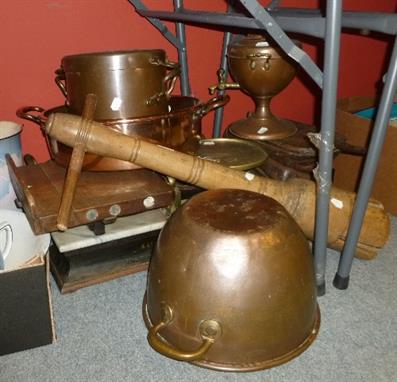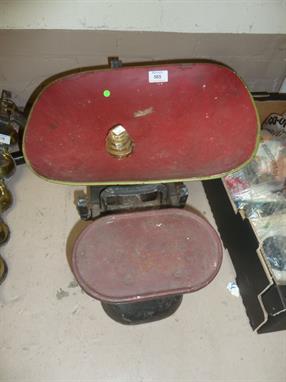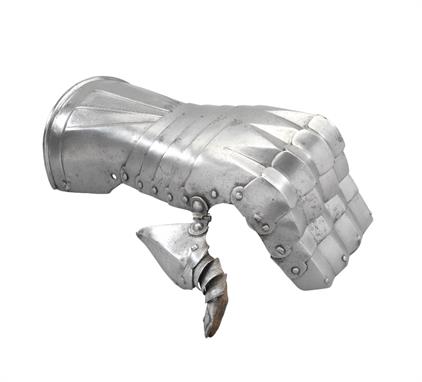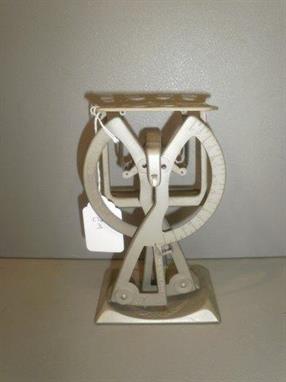We found 63833 price guide item(s) matching your search
There are 63833 lots that match your search criteria. Subscribe now to get instant access to the full price guide service.
Click here to subscribe- List
- Grid
-
63833 item(s)/page
A parcel lot to include a set of postal scales on wooden base with weights, a hand bell with turned wood handle, an oblong box, two wooden dwarf candlesticks, a pinchbeck filligree brooch, a maple box, a mother of pearl button hook (A/F) and a set of tortoiseshell effect plastic backed brushes, comb and mirror.
A TURKISH DAGGER, LATE 18TH/EARLY 19TH CENTURY with slightly curved single-edged blade stamped with a mark on one side (areas of surface rust), the tang partially enclosed by an engraved silver band (incomplete) and fitted with a pair of green stained horn grip-scales, each inlaid with numerous rondels filled with contrasting colours divided by brass fillets 18.5cm; 7 1/4in blade
AN INDIAN DAGGER, EARLY 19TH CENTURY with curved double-edged blade formed with a reinforced tip, cut with a pair of fullers divided by a medial rib and chiselled with a flower at the forte on each face, damascened steel hilt decorated with scrolling foliage, and a pair of shaped ivory grip-scales retained by three iron rivets 21.5cm; 8 1/2in blade
AN OTTOMAN SILVER-MOUNTED SHORTSWORD (YATAGHAN), TURKEY, 19TH CENTURY with slightly curved single-edged blade with later silver decoration on each side, iron hilt decorated en suite and a pair of horn grip-scales (chipped) rising to an eared pommel, in a contemporary wooden scabbard with large silver mounts embossed with flowers and foliage 60cm; 23 3/4in blade
AN INDIAN SWORD (TALWAR), AN AFGHAN DAGGER (PESH-KABZ) AND A BHUTANESE DAGGER, 19TH CENTURY the first with curved blade double-edged towards the tip, and rudimentary brass hilt of characteristic form; the second with slightly recurved reinforced blade, steel hilt (one half of the lower portion missing), and a pair of polished horn grip-scales; and the third with single-edged blade, white metal hilt, in its white metal scabbard the first: 80.5cm; 31 3/4in blade (3)
AN OTTOMAN SILVER-MOUNTED SWORD (YATAGHAN), TURKEY, 19TH CENTURY with slightly curved single-edged blade decorated in inlaid silver with scrollwork and brief inscriptions, parcel gilt silver hilt chased with beadwork and flowers (small repairs), ivory grip-scales rising to an eared pommel (one grip cracked), in an associated leather-covered wooden scabbard with large silver mounts decorated with scrolling foliage, beadwork and scale pattern 58.5cm; 23in blade
A TURKISH SILVER-MOUNTED SWORD (SHAMSHIR), EARLY 19TH CENTURY with associated curved single-edged blade with later silver decoration and calligraphy, silver hilt comprising engraved cross-guard with bud-shaped terminals, the langets struck with a mark (rubbed) on one side, and horn grip-scales rising to a bulbous pommel (washers missing), in a contemporary leather-covered wooden scabbard with large silver mounts embossed with trophies 79cm; 31 1/8in blade
A SOUTH GERMAN HALF-MITTEN GAUNTLET FOR THE LEFT HAND, CIRCA 1500-5 formed of a short flaring gutter-shaped cuff decorated at its straight upper edge with a plain inward turn accompanied by a recessed border, and at its centre with a spray of five flutes enclosed in each case by a pair of incised lines, five metacarpal plates, the lowest longer than the rest and each decorated at the centre of its upper edge with a V-shaped nick, a knuckle-plate and three finger-plates (the last restored), each formed like the lower end of the lowest metacarpal-plate with V-shaped flutes between the fingers, and an associated thumb-defence of five scales attached by a hinge to the inner end of the last metacarpal-plate 24.8 cm; 9¾ in Provenance The Metropolitan Museum of Art, New York, sold Christies 22-3 November 1960, lot 357 Literature Prof. P. L. Pratt, `Some Facets of Crystal Physics`, Inaugural Lecture, Imperial College, London, 21 January 1964, p. 161, pls IV & V Exhibition Arms & Armour Society, The Art of the Armourer, Victoria & Albert Museum, London, April to May 1963, cat. No. 12 (ill.) The gauntlet can be seen as transitional in character between the so-called `Gothic` and `Maximilian` fashions. It invites comparison with that shown hanging on a hook, together with a crossbow bolt and partridge, in a still-life picture painted by Jacopo de Barbari in 1504, and now in the Alte Pinakothek, Munich (Reverseau 1982, p. 52, fig. 4).
A SOUTH GERMAN FINGERED GAUNTLET FOR THE RIGHT HAND, NUREMBERG, LATE 16TH CENTURY formed of a long flared and pointed cuff with a short fixed separate inner plate, both plates decorated at their upper edges with a file-roped inward turns accompanied by recessed borders, and the outer plate decorated over the ulna with a small almond-shaped boss, five metacarpal-plates each decorated at the centre of its upper edge with a V-shaped nick, a knuckle-plate decorated with a file-roped transverse rib, a shaped finger-plate, four scaled finger-defences and a laterally-hinged thumb-defence of four scales, the outer plate struck externally with the crested helmet mark of its maker and the quality-control-mark of the City of Nuremberg, and internally with a reversed N in a circle, also of that city 41.0 cm; 16¼ in Provenance Possibly from the collections of the Dukes of Brunswick, at Wolfenbuttel, Lower Saxony Anon. sold Christie`s, London, 9 April 1975, lot 63 It has been suggested that the gauntlet is the pair to the one for the left hand formerly in the collections of the Dukes of Brunswick which was shown as part of a composite armour in the Exhibition of Arms, Armour and Militaria lent by H.R.H. The Duke of Brunswick at the Tower of London April 10th -October 31st 1952, cat. no.20, pp. 8-9. It is of the same form as the latter and bears the same marks as it, both internally and externally. These same marks are found, however, on other pieces of armour in the former collections of the Dukes of Saxe-Weimar-Eisenach in the Wartburg, Thuringia (Diener von Scönberg 1812, cat. Nos 48-9) Gauntlets of this length were for wear without vambraces.
A Pair of CloisonnŽ Enamel Qilin, Each modeled standing foursquare with long gilt whiskers, antlers, mane and a bushy tail, its mouth open exposing teeth and tongue, the body covered with turquoise and blue scales, the head decorated with red squares reserved against a blue ground. Early 20th Century, Length: 12 inches (30.5 cm) each [Overall wear, losses, chips, dents. This condition report states major condition issues only] Starting Price: $1000
Three Imperial Embroidered Roundels, The two dragon roundels worked in satin stitch and couched gold-wrapped thread to depict a five-clawed front-facing dragon; the first of slender sinuous form with finely embroidered scales entwining a `wanshou` medallion at the center, surrounded by green and blue cloud florets above rolling waves; the second shown wide-eyed while in pursuit of flaming pearls amidst cloud meanders and bats; the third smaller roundel of the Yuanshikai period and executed in a blue palette, bearing five of the twelve Imperial symbols including an ax, temple cup, grains of millet, sea grass and a central ÔfuÕ emblem, all enclosed by swirling clouds. Qing Dynasty, Diameter of Largest: 11 1/2 inches (29.2 cm) [Staining, holes, fraying, separations, minor thread losses. This condition report states major condition issues only] Roundels of this kind appeared on court surcoats as a clear indication of rank and status. The five-clawed dragon denotes imperial ranking, with the clockwise turn of each dragon`s body designating these roundels for placement on the left shoulder.Similarly, during the Yuanshikai Period (1912-1915), these roundels were worn by officials, with both the number of roundels on the surcoat, and the number of Imperial symbols included, signifying status.Closely related examples of these three roundels sold at Christie`s New York, The Imperial Wardrobe: Fine Chinese Costume and Textiles from the Linda Wrigglesworth Collection, March 19, 2008, lots 11, 32 and 81, respectively. Starting Price: $1500
A Pair of Cast Iron Stirrups, Each decorated with a grape vine motif, the insteps with overall patterns of stylized triangular iroko (fish scales) alternating in black lacquer and mother-of-pearl, the bases with incised signatures. Edo Period (17th/18th Century), Height: 10 inches (25.4 cm) each approximately [Overall wear, losses, dents. This condition report states major condition issues only] Starting Price: $500
-
63833 item(s)/page























































